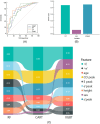Establishing a novel model to assess exercise capacity in chronic heart failure based on stress echocardiography
- PMID: 39219247
- PMCID: PMC11631253
- DOI: 10.1002/ehf2.15038
Establishing a novel model to assess exercise capacity in chronic heart failure based on stress echocardiography
Abstract
Aims: The aim of this study was to develop a simple, fast and efficient clinical diagnostic model, composed of exercise stress echocardiography (ESE) indicators, of the exercise capacity of patients with chronic heart failure (CHF) by comparing the effectiveness of different classifiers.
Methods and results: Eighty patients with CHF (aged 60 ± 11 years; 78% male) were prospectively enrolled in this study. All patients underwent both cardiopulmonary exercise test (CPET) and ESE and were divided into two groups according to the VE/VCO2 slope: 30 patients with VE/VCO2 slope ventilation classification (VC)1 (i.e., VE/VCO2 slope < 30) and 50 patients with VC2 (i.e., VE/VCO2 slope ≥ 30). The analytical features of all patients in the four phases (rest, warm-up, peak and recovery phases) of ESE included the following parameters: left ventricular (LV) systolic function, LV systolic function reserve, LV diastolic function, LV diastolic function reserve and right ventricular function. Logistic regression (LR), extreme gradient boosting trees (XGBT), classification regression tree (CART) and random forest (RF) classifiers were implemented in a K-fold cross-validation model to distinguish VC1 from VC2 (LVEF in VC1 vs. VC2: 44 ± 8% vs. 43 ± 11%, P = 0.617). Among the four models, the LR model had the largest area under the curve (AUC) (0.82; 95% confidence interval [CI]: 0.73 to 0.92). In the multiple-variable LR model, the differences between the peak-exercise-phase and resting-phase values of E (ΔE), s'peak and sex were strong independent predictors of a VE/VCO2 slope ≥ 30 (P value: ΔE = 0.002, s'peak = 0.005, sex = 0.020). E/e'peak, ΔLVEF, ΔLV global longitudinal strain and Δstroke volume were not predictors of VC in the multivariate LR model (P > 0.05 for the above).
Conclusions: Compared with the LR, XGBT, CART and RF models, the LR model performed best at predicting the VE/VCO2 slope category of CHF patients. A score chart was created to predict VE/VCO2 slopes ≥ 30. ΔE, s'peak and sex are independent predictors of exercise capacity in CHF patients.
Keywords: Cardiopulmonary exercise test; Chronic heart failure; Exercise capacity; Exercise stress echocardiography; Machine learning; VE/VCO2 slope.
© 2024 The Author(s). ESC Heart Failure published by John Wiley & Sons Ltd on behalf of European Society of Cardiology.
Conflict of interest statement
The authors declare that they have no conflicts of interest.
Figures



Similar articles
-
The role of right and left ventricular function in the ventilatory response to exercise in chronic heart failure.Circulation. 1994 May;89(5):2062-9. doi: 10.1161/01.cir.89.5.2062. Circulation. 1994. PMID: 8181130
-
The combined exercise stress echocardiography and cardiopulmonary exercise test for identification of masked heart failure with preserved ejection fraction in patients with hypertension.Eur J Prev Cardiol. 2016 Jan;23(1):71-7. doi: 10.1177/2047487315604836. Epub 2015 Sep 10. Eur J Prev Cardiol. 2016. PMID: 26358991
-
Gender and age normalization and ventilation efficiency during exercise in heart failure with reduced ejection fraction.ESC Heart Fail. 2020 Feb;7(1):371-380. doi: 10.1002/ehf2.12582. Epub 2020 Jan 1. ESC Heart Fail. 2020. PMID: 31893579 Free PMC article.
-
Ventilatory response to exercise improves risk stratification in patients with chronic heart failure and intermediate functional capacity.Am Heart J. 2002 Mar;143(3):418-26. doi: 10.1067/mhj.2002.120772. Am Heart J. 2002. PMID: 11868046
-
Ivabradine Improves Cardiac Function and Increases Exercise Capacity in Patients with Chronic Heart Failure.Int Heart J. 2019 Jul 27;60(4):899-909. doi: 10.1536/ihj.18-559. Epub 2019 Jul 12. Int Heart J. 2019. PMID: 31308326
Cited by
-
Noninvasive Oral Hyperspectral Imaging-Driven Digital Diagnosis of Heart Failure With Preserved Ejection Fraction: Model Development and Validation Study.J Med Internet Res. 2025 Jan 7;27:e67256. doi: 10.2196/67256. J Med Internet Res. 2025. PMID: 39773415 Free PMC article.
References
-
- Heidenreich PA, Bozkurt B, Aguilar D, Allen LA, Byun JJ, Colvin MM, et al. 2022 AHA/ACC/HFSA guideline for the management of heart failure: executive summary: a report of the American College of Cardiology/American Heart Association joint committee on clinical practice guidelines. J Am Coll Cardiol 2022; doi:10.1016/j.jacc.2021.12.011 - DOI - PubMed
-
- Bombardini T, Morrone D, Huqi A, et al. The relative prognostic value of different indices of global left ventricular function during stress echocardiography: the bright side of the force. Eur Heart J Cardiovasc Imaging 2019;20:i4. doi:10.1093/ehjci/jey277 - DOI
MeSH terms
Grants and funding
LinkOut - more resources
Full Text Sources
Medical

